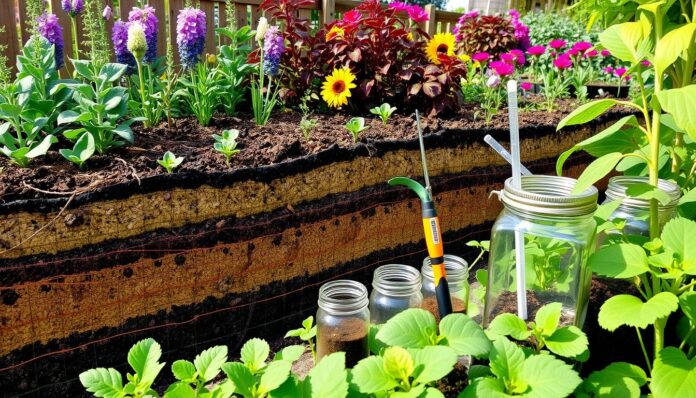What if the key to a thriving permaculture ecosystem is in the soil? Traditional methods might not be enough, as only 10% to 60% of fertilizer nutrients reach the plant. Advanced soil testing methods offer insights into soil health. This helps permaculturists make better decisions about soil management and ecosystem restoration.
Understanding soil, plants, and microorganisms is key to a sustainable ecosystem. Permaculture soil testing helps grasp soil health and its role in ecosystem restoration.
Introduction to Advanced Soil Testing
Soil fertility tests are vital for assessing soil health and fertility. Certification programs for agricultural Soil Nutrient Test laboratories ensure accurate results. This leads to better ecosystem restoration through permaculture soil testing and soil health assessment.
Key Takeaways
- Advanced soil testing methods are crucial for understanding soil health and its impact on ecosystem sustainability through permaculture soil testing.
- Only 10% to 60% of fertilizer nutrients actually benefit the plant, highlighting the need for more effective soil management strategies and soil health assessment.
- Soil fertility tests, including organic matter percentage, are essential for assessing long-term soil health and fertility, and can be achieved through permaculture soil testing.
- Certification programs for agricultural Soil Nutrient Test laboratories ensure accuracy and precision of results, leading to better ecosystem restoration through soil health assessment.
- Permaculturists can create a more sustainable and resilient ecosystem by understanding the complex relationships between soil, plants, and microorganisms, and applying permaculture soil testing methods.
- Soil health assessment is critical for ecosystem restoration, and can be achieved through advanced permaculture soil testing methods.
Understanding Soil Health in Permaculture
Soil health is key in permaculture. It shows how well the ecosystem is doing. Practices like composting and cover cropping boost soil health. They add organic matter and help nutrients cycle better.
These methods also cut down on the need for harmful chemicals. This makes farming more sustainable and good for the environment.
Soil health is shown by how well it supports nutrient cycling. Cover crops help by fixing nitrogen and other nutrients. Adding organic matter also makes soil better at holding water and nutrients.
By using these methods, farmers can help soil life, reduce erosion, and grow more food.
- Improved soil fertility and structure
- Increased crop yields and quality
- Enhanced nutrient cycling assessment and water retention
- Reduced soil erosion and pollution
By focusing on soil health and using regenerative practices, farmers can make farming better. This helps the environment and makes ecosystems more productive.
| Practice | Benefit |
|---|---|
| Composting | Improves soil fertility and structure |
| Cover cropping | Enhances nutrient cycling assessment and water retention |
| Organic mulching | Reduces soil erosion and pollution |
Basics of Soil Testing for Permaculture
Soil testing is key in permaculture. It gives insights into soil health and fertility. Permaculture soil testing looks at the soil’s chemical, physical, and biological properties. This helps decide on soil management and fertilizer use.
A good soil sample mixes 8 to 12 samples together. The first six inches are sampled for accuracy. The soil fertility testing checks about 14 elements, like pH and nutrients. But, not all labs test Cation Exchange Capacity (CEC), which is important for nutrient availability.
Organic soil analysis is very important. It finds nutrient gaps and contaminants. This info helps in choosing fertilizers, irrigation, and crop rotation. It boosts soil health, increases yields, and lowers environmental impact.
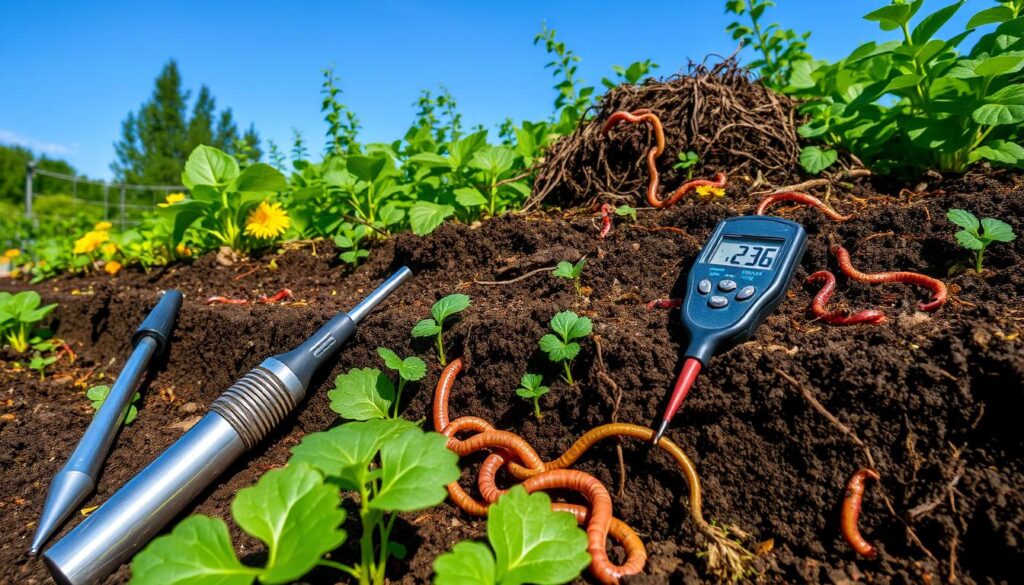
- pH levels and their impact on nutrient availability
- Nutrient content, including macro- and micronutrients
- Organic matter content and its role in soil fertility
- Cation Exchange Capacity (CEC) and its relationship to soil nutrient availability
Knowing these factors helps farmers and gardeners. They can make their farming more sustainable and productive. This is crucial for keeping soil healthy and fertile.
| Soil Test | Importance |
|---|---|
| pH Test | Determines soil acidity and nutrient availability |
| Nutrient Test | Identifies nutrient deficiencies and excesses |
| Organic Matter Test | Assesses soil fertility and structure |
Components of a Comprehensive Soil Test
A comprehensive soil test is key for soil health assessment. It gives a detailed look at the soil’s physical, chemical, and biological sides. This info is vital for knowing how well the soil cycles nutrients and monitors biodiversity.
The test checks soil pH, nutrient levels, and organic matter. These are crucial for healthy soil. For instance, the right pH and nutrient levels help support many microorganisms. These microbes are key for soil biodiversity monitoring.
It also looks at soil texture, structure, and how it holds water. This info helps in making choices like when to use fertilizers. It also spots problems like soil compaction or erosion. With this info, farmers and gardeners can keep their soil healthy and productive.
When looking at soil test results, consider a few things:
- Soil pH and its effect on nutrient availability
- Nutrient levels and any shortages or too much
- Organic matter and its role in soil health
By thinking about these points and using soil test data, people can make smart choices about soil care. This leads to healthy, productive soil that supports soil biodiversity monitoring and nutrient cycling assessment.
Advanced Soil Testing Techniques
Advanced soil testing is key to understanding soil health in permaculture. It helps assess the soil’s physical and chemical properties. This is vital for effective regenerative agriculture practices. Electrical conductivity testing, for example, measures how well the soil conducts electricity. It gives insights into its salinity and nutrient levels.
Soil texture analysis is also crucial. It determines the soil’s sand, silt, and clay particle mix. This mix affects drainage, aeration, and water-holding capacity. Knowing this helps in soil fertility testing and choosing the right crops and practices. These techniques help farmers and gardeners improve their soil’s potential. This leads to better crop yields and more sustainable farming.
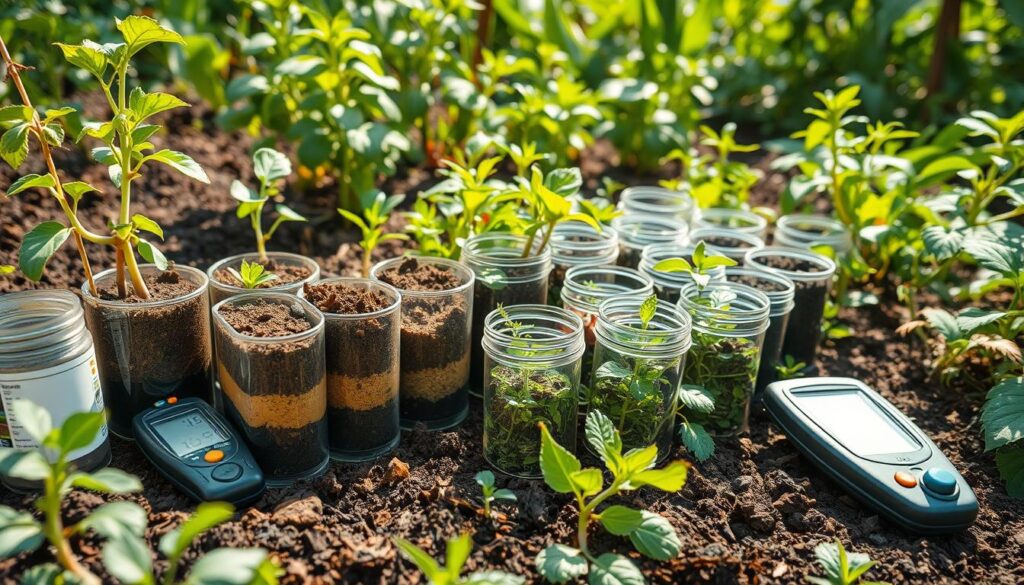
The following table summarizes the key components of advanced soil testing techniques:
| Technique | Description |
|---|---|
| Electrical Conductivity Testing | Measures soil salinity and nutrient levels |
| Soil Texture Analysis | Determines proportion of sand, silt, and clay particles |
By using these advanced techniques, farmers and gardeners can make their ecosystems more sustainable and productive. This helps create a healthier environment for all.
The Role of Microorganisms in Soil Health
Microorganisms are key to soil health. They help with nutrient cycling, ecosystem function, and plant growth. A soil health assessment can show if beneficial microorganisms are present and active. In healthy topsoil, billions of microorganisms work together to break down and make nutrients available.
Monitoring soil biodiversity is vital to grasp the complex relationships between microorganisms and their environment. This can be done through ecosystem restoration methods. These methods help grow beneficial microorganisms. For example, introducing mycorrhizal fungi and Rhizobium bacteria can enhance soil health and fertility.
The advantages of microorganisms in soil health are many. They can fix nitrogen, make phosphorus available, and create substances that help plants grow. A diverse ecosystem with various microorganisms is crucial for soil health and fertility. Sustainable practices like crop rotation and organic amendments can improve soil health. This reduces the need for chemical fertilizers and pesticides.
| Microorganism | Function |
|---|---|
| Mycorrhizal fungi | Plant growth promotion, nutrient uptake |
| Rhizobium bacteria | Nitrogen fixation, plant growth promotion |
Interpreting Soil Test Results
Understanding soil test results is key to knowing your soil’s health. Permaculture soil testing shows the soil’s nutrient levels. This helps farmers and gardeners manage their soil better. To get the most from soil test results, you need to know about pH levels, nutrient content, and organic matter.
A soil test report shows the soil’s pH level, which tells if it’s acidic or alkaline. Most plants like a slightly acidic to neutral soil pH, between 6.0 and 7.0. Soil fertility testing also looks at the soil’s nutrient levels, like nitrogen, phosphorus, and potassium.
Understanding Soil Test Reports
A soil test report will have several key pieces of information:
- pH level
- Nutrient content (N, P, K)
- Organic matter assessment
- Cation exchange capacity (CEC)
Making Sense of Soil Nutrient Ratios
Soil nutrient ratios are crucial for soil fertility. A balanced soil has the right amounts of nitrogen, phosphorus, and potassium. Organic soil analysis can spot nutrient imbalances. This lets you add the right amendments to boost soil fertility.
| Soil Component | Optimal Level |
|---|---|
| pH | 6.0-7.0 |
| Nitrogen (N) | 10-20 ppm |
| Phosphorus (P) | 5-10 ppm |
| Potassium (K) | 100-200 ppm |
By grasping soil test results and nutrient ratios, farmers and gardeners can improve soil health. Regular permaculture soil testing and soil fertility testing catch issues early. This ensures your soil stays healthy and fertile.
Remediation and Soil Improvement Strategies
Checking soil health is key to finding the best ways to fix and improve it. Using cover crops and organic amendments in regenerative agriculture can really boost soil health. For example, cover crops like buckwheat and red clover make soil better and add more nutrients.
A soil health assessment shows where to use these methods to better the soil. These practices help keep water in the soil, stop erosion, and make crops grow better. Phytoremediation, or using plants to clean soil, is also a great way to fix the environment.
Here are some recommended seeding rates for cover crops in permaculture:
- Buckwheat: 60-75 lbs/A
- Red Clover: 8-10 lbs/A
- Hairy Vetch: 30-40 lbs/A
These cover crops can make the soil healthier and support farming that’s good for the planet.
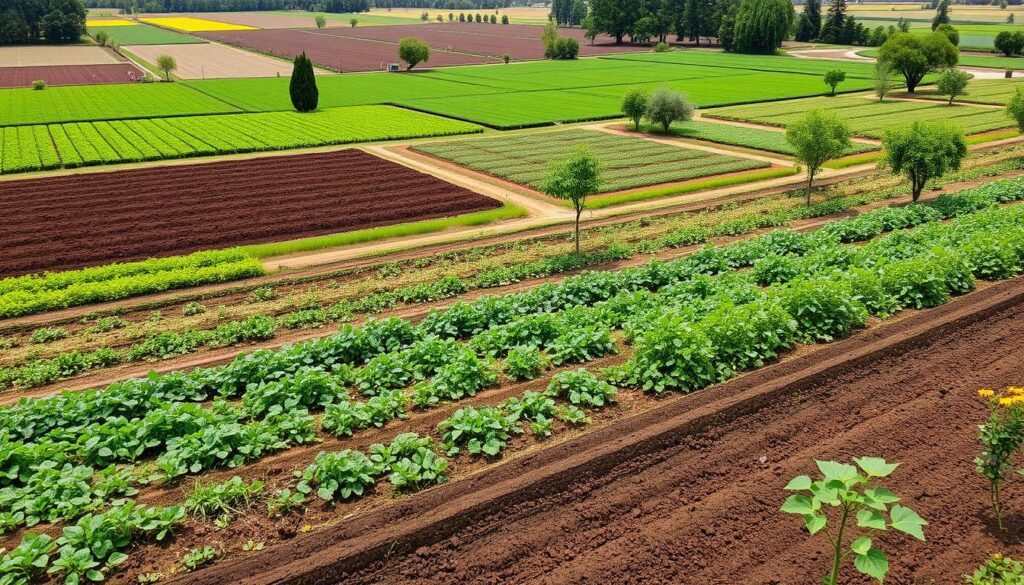
Farmers can make their soil better, grow more food, and help the environment by using these methods. Practices like cover crops and organic amendments fight climate change by trapping more carbon and cutting down on synthetic fertilizers.
| Cover Crop | Seeding Rate (lbs/A) | Benefits |
|---|---|---|
| Buckwheat | 60-75 | Improves soil structure, increases nutrient availability |
| Red Clover | 8-10 | Fixes nitrogen, improves soil fertility |
Sustainable Practices to Enhance Soil Health
Soil health is key for a strong ecosystem. Permaculture soil testing finds areas needing help. It lets us focus on fixing them. Soil fertility testing checks the soil’s nutrient levels.
Using sustainable methods like crop rotation and biodiversity boosts soil health. These methods also reduce erosion and increase organic matter. Organic soil analysis shows the best ways for different soils.
Crop Rotation and Biodiversity
Crop rotation and biodiversity keep soil healthy. They add nutrients, stop pests, and help soil life. Benefits include:
- Soil gets better structure and fertility
- Crops grow better and taste better
- Less soil erosion and nutrient loss
Minimal Soil Disturbance
Keeping soil undisturbed is also vital. It cuts down erosion, helps soil life, and boosts organic matter. Benefits include:
- Better water absorption and keeping
- Less soil compaction and erosion
- Soil gets more fertile and crops grow better
Utilizing Technology in Soil Testing
Technology is playing a big role in permaculture soil testing. It brings new tools and methods to check soil health. This includes remote sensing, soil mapping, and mobile apps for soil testing. These tools help farmers and gardeners understand their soil better and make smarter choices for regenerative agriculture practices.
Using technology in soil testing has many advantages. It makes testing more accurate and efficient. For instance, remote sensing can scan large areas of soil. Mobile apps give quick access to soil test results. These tools also pinpoint where soil fertility testing is needed, helping to use resources better.
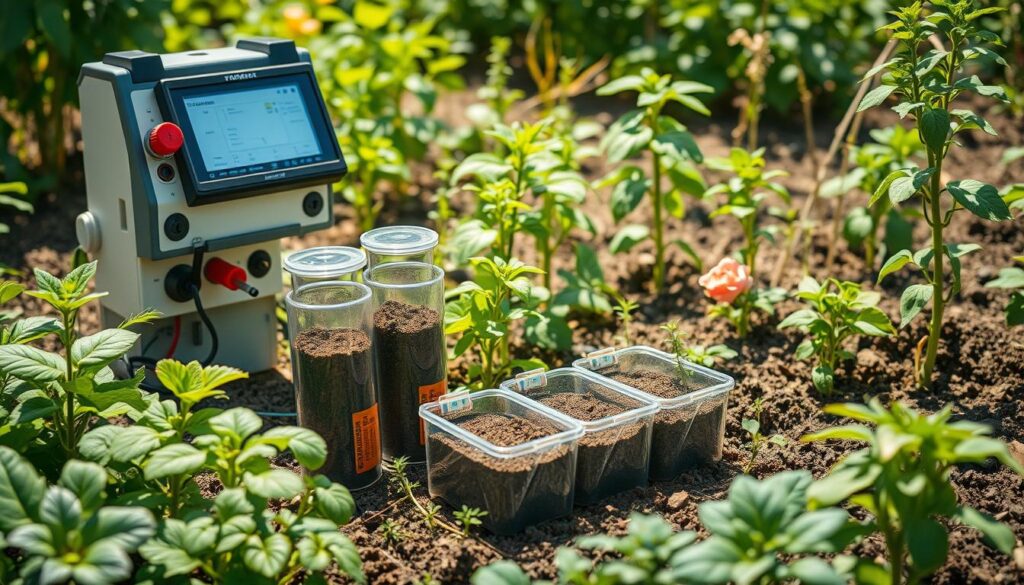
Technology also makes soil testing cheaper and simpler. Mobile apps guide on how to collect and prepare soil samples. Online platforms offer access to soil testing labs and resources. By using these technologies, farmers and gardeners can make better decisions about their permaculture soil testing and regenerative agriculture practices. This leads to healthier soils and more sustainable farming.
| Technology | Benefits |
|---|---|
| Remote Sensing | Increased accuracy and efficiency |
| Mobile Apps | Quick and easy access to soil test results |
| Online Platforms | Access to soil testing labs and other resources |
Case Studies: Successful Permaculture Projects
Permaculture soil testing has played a key role in many projects worldwide. It helps farmers and researchers find ways to improve soil health. For example, a study showed that permaculture sites had 27% more soil carbon than control fields. They also had 20% lower soil bulk density.
This shows how crucial permaculture soil testing is for healthy ecosystems. By analyzing soil samples, farmers can make better choices. They can improve soil fertility and structure. This leads to better crops, more biodiversity, and stronger ecosystem services.
Some successful permaculture projects include:
- The Jajarkot Permaculture Programme in Nepal, which works with 150 villages to promote sustainable agriculture and ecosystem restoration.
- The Himalayan Permaculture Center, which collaborates with 850 households in Surkhet and Humla to promote permaculture practices and improve soil health.
- Hasera Agriculture Farm, which operates with 20 households and focuses on community development and sustainable agriculture.
These projects show the power of permaculture soil testing and ecosystem restoration. They improve soil health, support biodiversity, and help sustainable agriculture. By working together, farmers and researchers can build more resilient food systems.
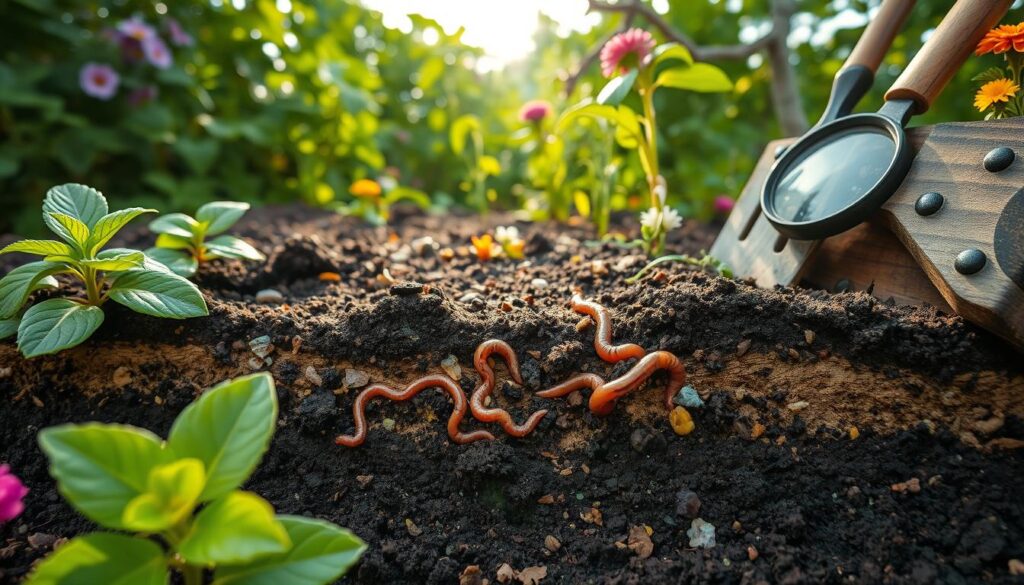
| Project | Location | Number of Households |
|---|---|---|
| Jajarkot Permaculture Programme | Nepal | 150 villages |
| Himalayan Permaculture Center | Surkhet and Humla | 850 households |
| Hasera Agriculture Farm | Nepal | 20 households |
DIY Soil Testing Methods
For gardeners and permaculture fans, knowing their soil’s health is key. While lab tests for permaculture soil testing give deep insights, DIY methods are cheaper and easier. The jar test is one way to check soil texture and makeup by mixing it with water in a jar.
Soil fertility testing is vital for DIY soil checks. It shows the soil’s nutrient levels. Home kits help figure this out, asking about the soil’s use to guide nutrient advice. Also, organic soil analysis looks at the soil’s organic matter. This boosts nutrient holding, improves drainage, and lessens compaction.
Redmond Agriculture offers affordable DIY kits with prepaid envelopes for return. It’s important to follow the kit’s instructions and take samples from various spots for a true soil health picture.
Regular DIY soil tests help gardeners and permaculture fans see soil health changes. They can then decide on the right soil amendments. Whether using DIY kits or lab tests for permaculture soil testing, the aim is a healthy soil that supports plants and biodiversity.
| Soil Type | Texture | Organic Matter Content |
|---|---|---|
| Clay | Finest | Low |
| Sandy | Coarsest | Low |
| Loamy | Balanced | Medium |
Collaborating with Soil Testing Labs
Working with soil testing labs can give you deep insights into soil health. They have the tools and knowledge to test your soil accurately. This helps in understanding and improving your soil’s health.
Soil pH levels between 6.0 and 7.0 are best for most crops. Testing your soil regularly can show what nutrients it needs. This can help in using fertilizers more effectively.
Some key benefits of working with soil testing labs include:
- Access to advanced testing equipment and techniques
- Expert interpretation of soil test results
- Personalized recommendations for soil improvement
When picking a lab, look at their experience with permaculture soil testing. Also, check the range of tests they offer and their reputation. A good lab will help you understand your soil better, supporting your efforts to restore it.
Initiatives like the Mission ‘A Soil Deal for Europe’ are working to improve soil health. They aim to make Europe’s soils healthy by 2030. These efforts show the value of working together to improve soil health.
| Soil Testing Method | Benefits |
|---|---|
| Permaculture soil testing | Provides comprehensive insights into soil health and ecosystem restoration |
| Regular soil analysis | Helps determine specific nutrient levels and informs fertilizer application |
The Future of Soil Testing in Permaculture
Permaculture is growing fast as a way to make farming better. New ways to test soil are coming up. These new methods are more precise, quicker, and cheaper. They use things like remote sensing, mobile apps, and advanced labs to check soil health.
Innovations and Trends in Soil Testing
Drones and satellites are now used to map soil. This gives a detailed view of soil health over big areas. Also, there are small devices for testing soil right where you are. This lets farmers and gardeners quickly decide on soil care.
Integrating Technology for Better Results
Using new soil testing and farming methods can really improve soil health. With the latest tech, farmers can learn more about their soil. They can see how fertile it is, what microbes are there, and how nutrients move. This helps them make better choices for their soil.

